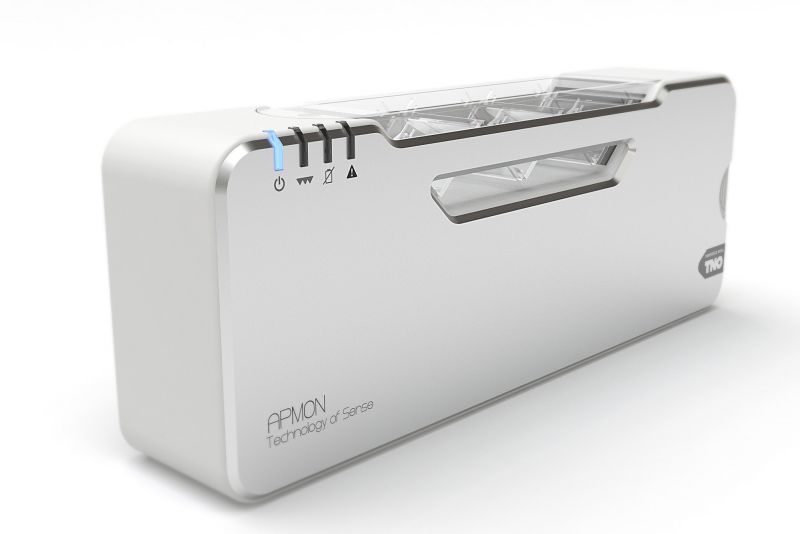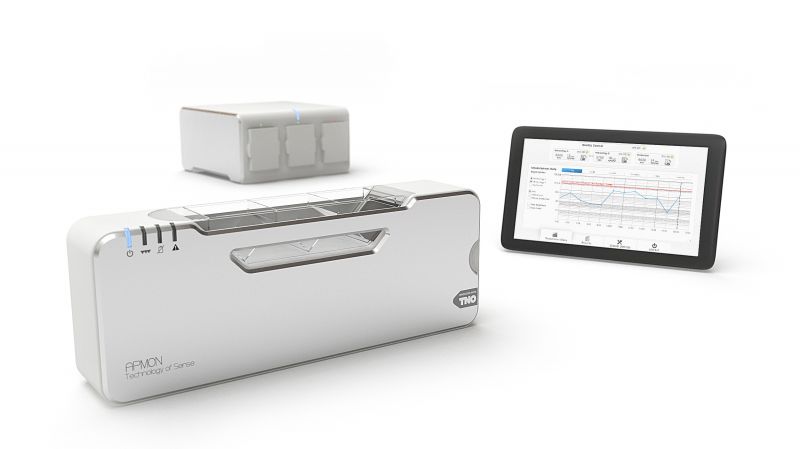Advanced Particle Deposition Monitoring
APMON PRO
Advanced Particle Deposition Monitoring
-
Advantages of the APMON
o Monitoring operation quality of the cleanroom
- Investigate local cleanroom quality
- Determine events of (higher) particle deposition
o Evaluate the effect of control measures
- Cleaning
- Clothing
- Behavior
o Risk assessment during product exposure.
o Improve working methods with respect to the product.
o Determine the impact of measures to improve local cleanliness.
o Determination of cleaning frequency
o Create awareness of personnel
Detail Specification
Real time measurement of particle deposition will cause a revolution
Much attention in clean rooms is currently given to airborne particles. But product quality is not harmed by small particles in air that do not deposit, but by larger particles that do fall onto the product. Particle deposition occurs even in the best clean rooms where people are working or machines are running. This is amply demonstrated experimentally, with cumbersome, slow and expensive methods. The award-winning invention of APMON, an affordable, stand-alone, real time deposition measurement system changes this radically. It can be used as an alarm, for training staff, finding root causes of particle deposition and even for setting standards on particle deposition in clean rooms.
Large particles of 10 to 100 micron fall on products, even in the cleanest clean room. That would seem impossible given the extensive air filtering and smart air flows, but is a reality in all clean rooms where people or machines are working. Particle filtering ensures that the air entering the room is virtually particle free and certainly devoid of such large particles. It is an essential condition for clean production, but not a sufficient one. Machines that are running and people that are working cause particles deposition within the clean room. Walking and working produces particles, and cleaning and other ways of touching of surfaces causes resuspension of settled particles into the air. The closer this happens to the critical surface of a product, the larger the probability that particles deposit on it. Although a good clean room is designed such that particles are pushed away from those surfaces, this protection is never complete. Large particles in particular are least affected by the air flows.
Fall-out
In order to combat particle deposition and thus increase yield of processes in clean rooms, it is essential to find the root causes of deposition. Therefore, it is essential to be able to measure it. All current methods for particle deposition, or particle fall-out, involve witness plates. These are placed on a surface for a minimum period, typically 24 hours. These witness plates need to be carefully placed and collected, in order not to contaminate them due to handling. After collection they are typically hand-fed into some sort of surface analysis instrument. These are typically slow and expensive. The instruments yield a particle size distribution that can be translated to a particle deposition class (PDC). All the hard work yields this little piece of information, which is valuable nevertheless.
Witness
Koos Agricola, clean room controller at Océ in The Netherlands, has shown that determining the PDC can be used to demonstrate the effectiveness of several particle control measures, such as cleaning more frequently and improved clothing. By placing numerous witness plates at different locations, he also found machines (or workers) that are particularly effective particle spreaders. This requires a huge amount of labour, a very meticulous way of working and a particular stamina. The return on such an investments probably is positive, but is measured in terms of yield improvement which may be difficult to quantify. Consequently, this type of work is rarely done. Also, routine measurements of PDC are often done infrequently if at all. And even when they are performed, results are obtained after more than 24 hours, so that a considerable production loss can have occurred meanwhile. Finally, no international standard on particle deposition is accepted currently, amongst others because no easy and affordable measurement technique is available up to now.
Fast
APMON, the Advanced Particle MONitor, has changed all this. An optical system automatically takes a snap shot of a total surface of about 60 cm2 every few minutes. Each snap shot is compared to the previous one, counting and sizing any additional particles. This is translated to PDC-levels automatically and continuously. A system consists of a monitor (with a maximum of six monitors, so you can determine PDC-levels at six different locations at the same time) and a base unit that performs the calculations and stores the data. When more particles are deposited than allowed in the time between the two snap shots, an alarm can be set off. The user can set the alarm-level (or allowed PDC) as well as the location of the alarm:
either on the monitor itself, at the central station or at the desk of the clean room controller. Maintenance of APMON is simple. Once in a while, the disposable witness cartridge onto which the particles deposit needs to be replaced. The time in between replacement depends on the quality of the clean room and can vary between two to three weeks. The system autocalibrates itself when the new witness cartridge is placed and subsequently at every snap shot. Data are stored automatically and management reports are easily extracted from the system.
Standard
Little labour is therefore involved in setting up and maintaining PDC-control of clean rooms using APMON. As system investment costs are comparable to current systems, clearly APMON will be less expensive in use. But the main advantage is that measurements are real time and at least a factor 150 times faster than current measurements. This allows for direct action, stopping production or covering up patients, that can control damage due to bursts of particle deposition. Also, it shows almost unequivocally what is the event that caused the burst, for instance floor cleaning, a lunch break with many people walking or an inexperienced operator. Thus, APMON is ideally suited for training staff, as well as for quality control in clean rooms and operating theatres. All the more reason to set clear standards for PDC in different clean room types. There is no doubt that clean room controllers and other experts understand the value of AMPON. It recently won the Cleanroom Innovation Award at Cleanzone 2012 in Frankfurt, Germany. No less than 80 percent of the visitors voted for APMON, whereas in total five products were nominated.
We expect that APMON will cause a revolution in clean room control. Infrequent airborne particle measurements remain necessary to check air filtering. But the working horse for contamination control will become the particle deposition measurement.


